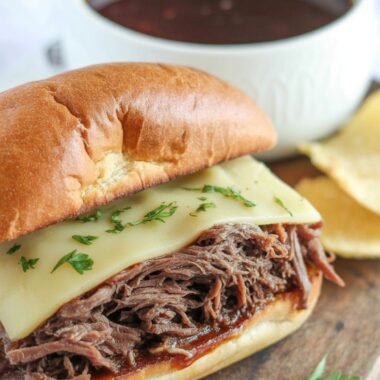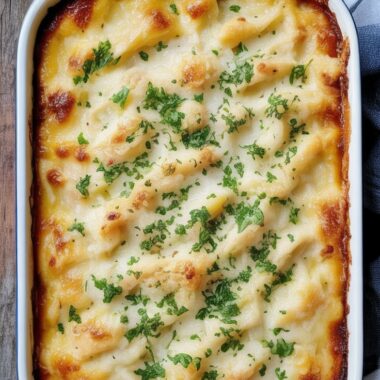If you’ve never tried Kashke Bademjan before, let me tell you—you’re in for something really special. This creamy Persian eggplant dip is rich, savory, and full of flavor from caramelized onions, garlic, dried mint, and of course, kashk (or a good creamy substitute if you can’t find it). It’s one of those dips that feels fancy enough for guests but is easy enough to make on a weeknight.
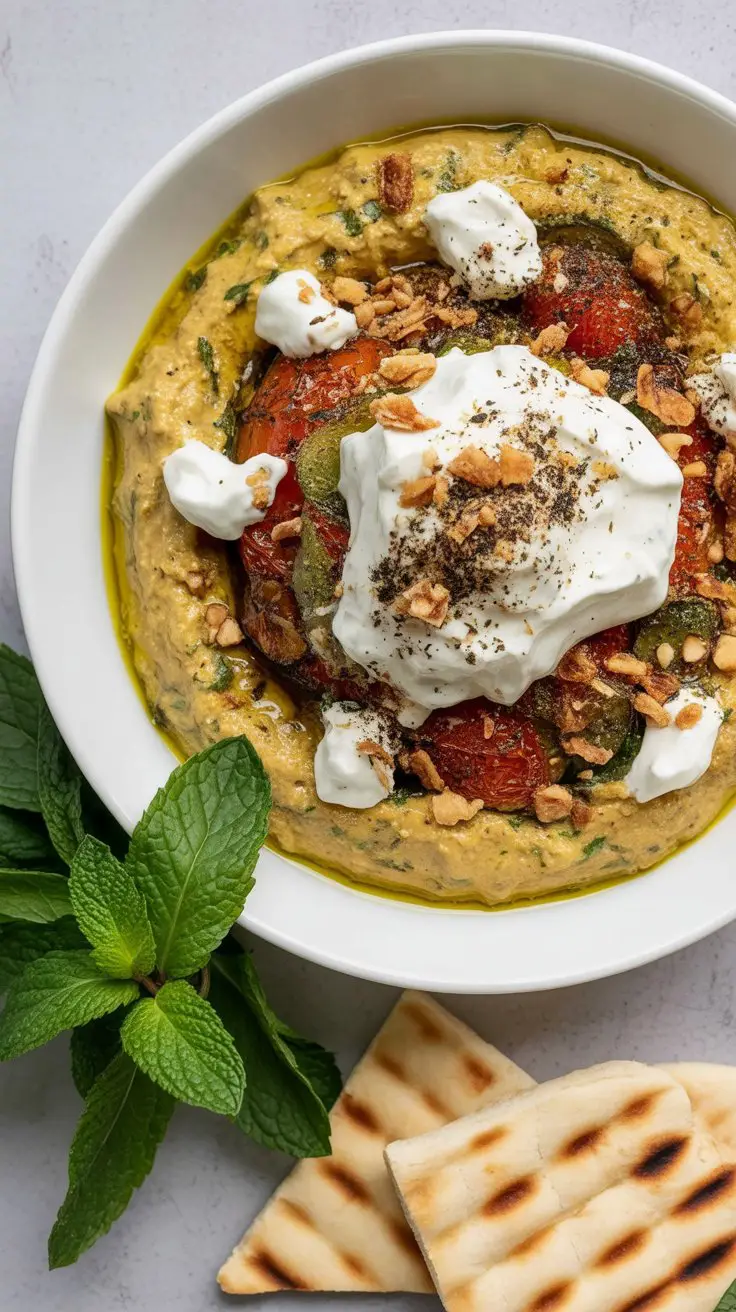
I first tasted this at a Persian friend’s family gathering, and I’ve been obsessed ever since. I’ve since worked it into my own kitchen rhythm with a few tweaks—like roasting the eggplants instead of frying—to make it lighter but still full of flavor. And trust me, even my mom, who loves everything the traditional way, gave this version a big thumbs-up.
A Little Background on This Creamy Dip
“Kashke” is a kind of fermented yogurt that adds a tangy, creamy punch to Persian dishes, and “Bademjan” simply means eggplant. So this dish is exactly what it sounds like—eggplant cooked down and mashed, then folded into a creamy, spiced mixture that’s served warm with bread. It’s one of those appetizers that disappears fast from the table. I’ve even eaten it cold straight from the fridge the next day with leftover pita chips. No regrets.
What Is Kashk, and What If I Can’t Find It?
Kashk might sound exotic, but at its core, it’s a thick, tangy by-product of yogurt, kind of like a salty, sour yogurt sauce. You can buy it in liquid form or reconstitute it from dried kashk, depending on what’s available near you.
If you’re like me and sometimes your pantry is more creative than stocked, don’t worry. Full-fat sour cream or thick Greek yogurt work beautifully. You’ll still get that creamy richness and a hint of tang, and honestly, nobody will know unless you tell them.
What You’ll Need
Here’s what goes into my go-to version of Kashke Bademjan:
- Eggplants: Go for the bigger, darker ones. They’re meatier and less bitter. I prefer roasting over frying—they still get that beautiful caramelization but with way less oil. Plus, it saves me the cleanup!
- Kashk: Or your backup—sour cream or Greek yogurt. Either way, this is what gives the dip that unmistakable creaminess.
- Onions & Garlic: These get sautéed until golden and fragrant—this base adds sweetness and depth.
- Olive Oil: Use a generous drizzle—it brings everything together and adds richness.
- Turmeric Powder: Just a small pinch gives the dish a gorgeous color and a warm undertone.
- Dried Mint: An absolute must! It adds that signature Persian aroma. I toast mine lightly in oil to bring out the flavor.
- Vegetable Stock: Helps simmer the eggplant mixture. If you’re out of stock, plain water works too.
- Walnuts: Optional but highly recommended. I toast them beforehand to bring out their nutty flavor—they add the perfect bit of crunch.
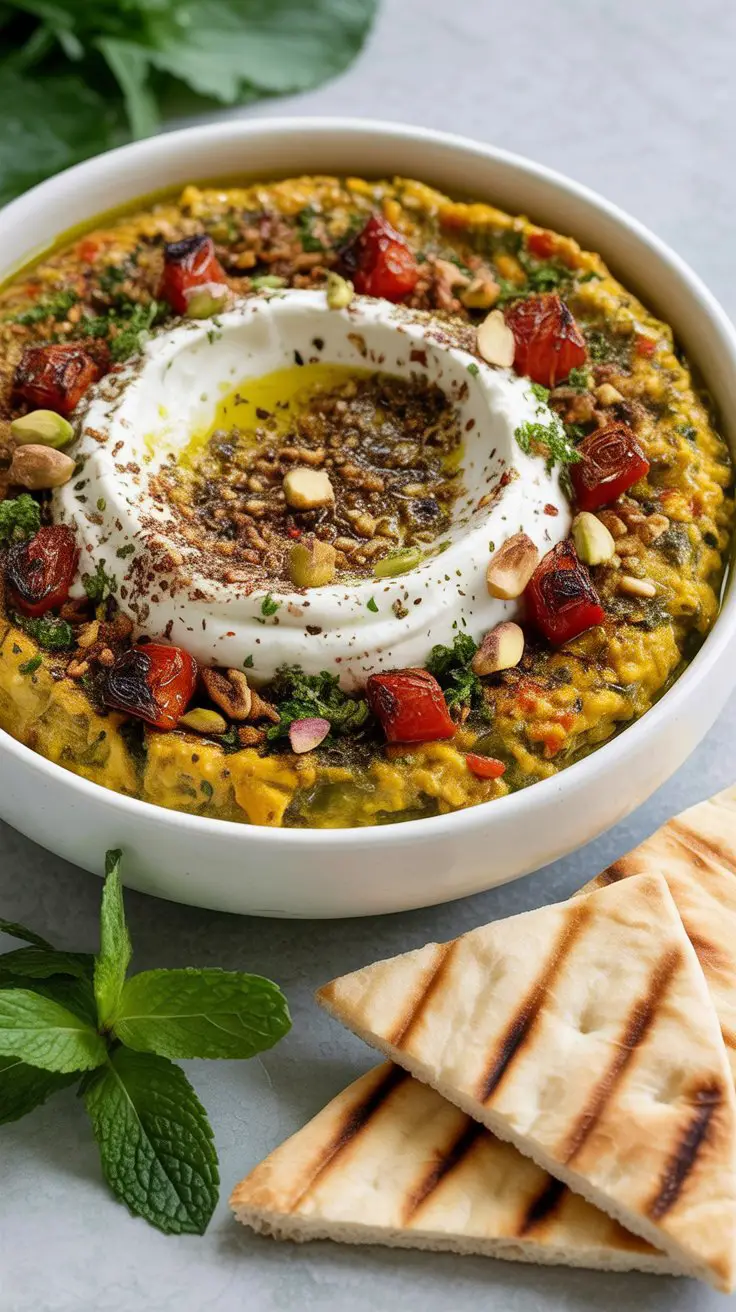
How to Dress It Up
One of the things I love about this dish is how beautifully it plates. Here are a few garnish options that I keep on hand:
- A drizzle of extra kashk (or your chosen substitute)
- Golden caramelized onions (don’t skip this—it’s magic)
- Toasted dried mint in olive oil
- A pinch of bloomed saffron if you’re feeling fancy
- A few chopped walnuts for crunch
Even if you go simple with just the onions and yogurt, it’ll still be a showstopper.
Roasting vs. Frying Eggplants (Why I Changed My Mind)
Traditionally, eggplants are fried for this dish—and they do taste delicious that way. But eggplants are basically sponges and love soaking up oil. I found roasting gives them that deep, sweet flavor without turning the whole dish greasy.
I roast them cut-side down at 180°C/350°F until they collapse and caramelize—usually around 45 minutes. Once they’re out, just scoop the flesh and you’re halfway there. My mom was skeptical the first time I did this, but she was pleasantly surprised. Now even she roasts her eggplants more often than not.
Let’s Make It: Step-by-Step
1. Prep the Eggplants
Slice them lengthwise, score them with diagonal cuts, and let them sit with a bit of salt to sweat out any bitterness. After 15–20 minutes, pat them dry, drizzle with olive oil, and roast them face down until they’re golden and soft.
2. Make the Base
In a pan, sauté onions until soft, then add garlic, turmeric, and dried mint. Let the spices bloom in the oil—just a few minutes to release their aroma.
3. Bring It All Together
Add in the eggplant flesh, vegetable stock, and toasted walnuts. Let everything simmer on low heat until it thickens and comes together like a soft mash.
4. Creamy Finish
Stir in your kashk or substitute and mix gently. Let it sit a few minutes off the heat—it thickens as it cools slightly. I usually sneak a spoonful here. You’ve been warned.
5. Plate and Garnish
Spoon it into a shallow bowl and add your toppings—extra caramelized onions, a swirl of yogurt, maybe some walnuts, and a sprinkle of dried mint. Serve warm with Persian bread or pita, and dig in.
My Handy Tips for Making It Perfect
- Salt the Eggplants: Just a quick sprinkle and rest helps reduce bitterness.
- Roast Cut Side Down: Keeps the eggplants tender and prevents drying.
- Don’t Burn the Mint: Sauté gently in oil with turmeric—it can go bitter fast.
- Use What You Have: Kashk is lovely, but Greek yogurt or sour cream will still give you an amazing dish.
- Toast Your Walnuts: Just a few minutes in a dry pan will make them taste so much better.
How I Serve This at Home
I love serving Kashke Bademjan warm, almost like a creamy side dish, with soft flatbread or lavash. Sometimes I’ll pair it with Shirazi salad and a cup of mint tea for a light but satisfying lunch. It’s also a hit at parties—I just pop it into a small cast iron dish, garnish it beautifully, and watch it vanish.
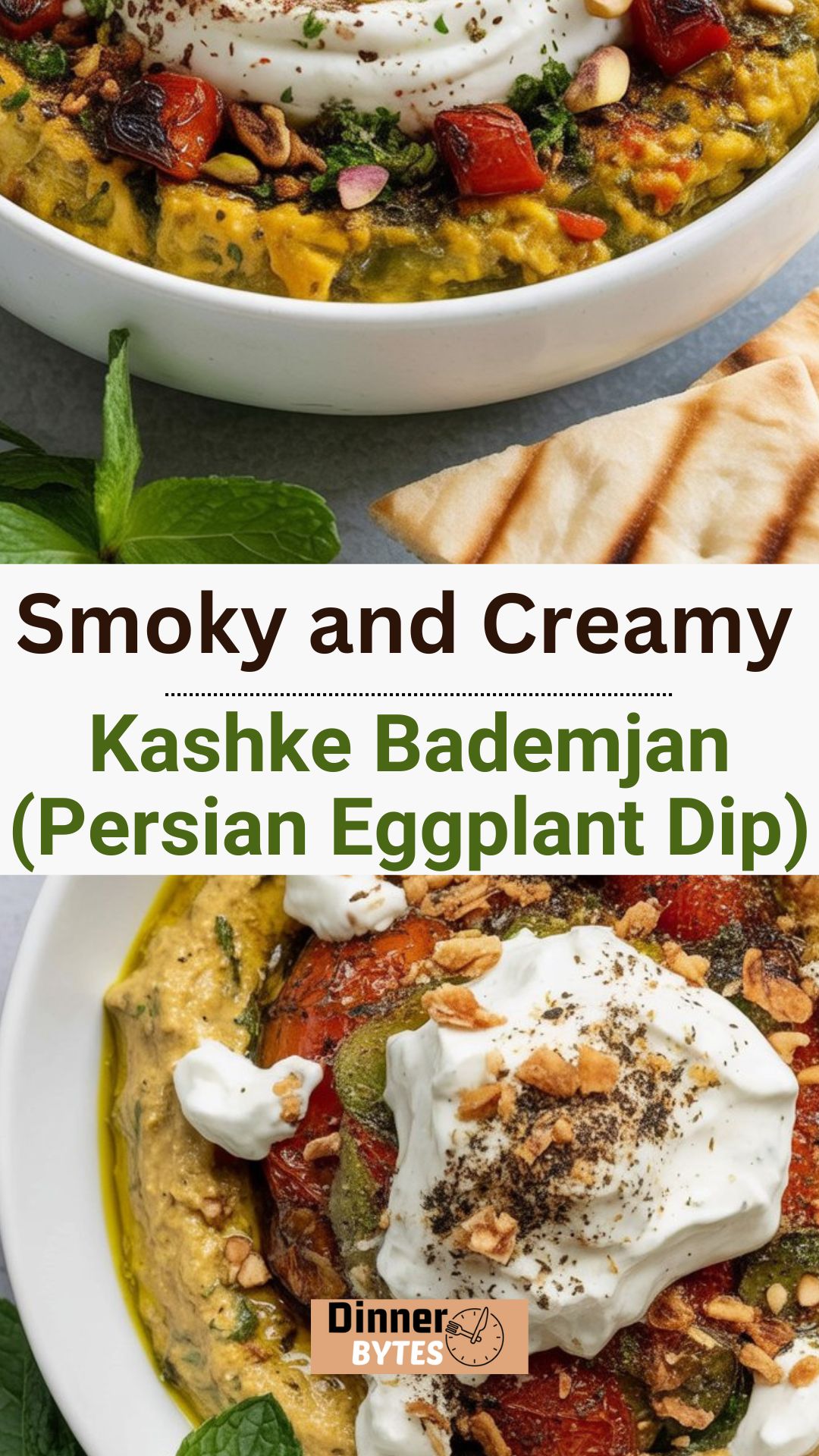
Storing and Making Ahead
You can absolutely make this ahead—just skip the final garnish and keep it covered in the fridge for up to 3 days. Reheat gently on the stovetop or microwave, stir in a splash of water if it thickens too much, and finish with fresh garnish before serving.
It actually tastes better the next day, once all those flavors have had time to meld together.
Kashke Bademjan (Persian Eggplant Dip)
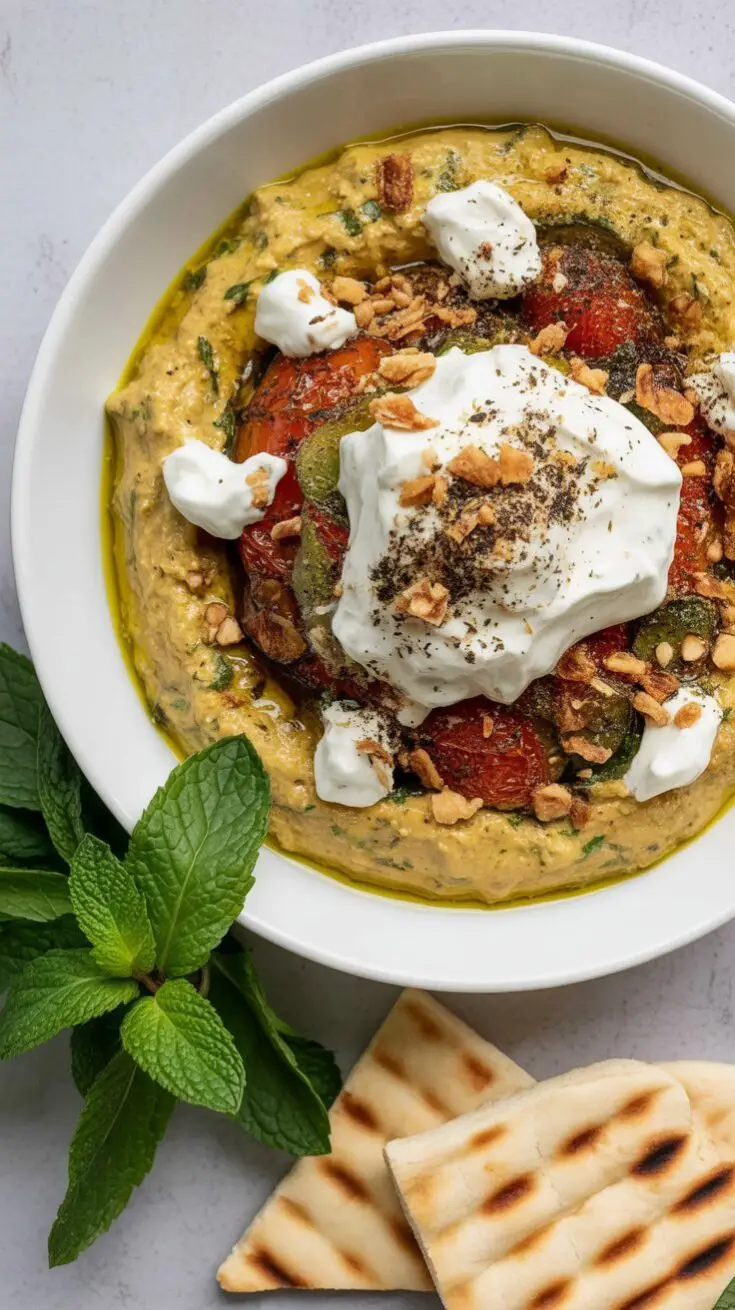
Creamy, smoky, and full of bold Persian flavor—Kashke Bademjan is one of those warm eggplant dips that steals the show at any gathering. Whether you’re scooping it up with pita or spreading it on Barbari bread, it’s a comforting appetizer that’s surprisingly easy to make at home. The key? Roasted eggplant, golden caramelized onions, and a dollop of tangy kashk (or Greek yogurt if that’s what’s in the fridge). Let’s bring this Middle Eastern favorite to your kitchen.
Ingredients
- 4 medium eggplants (around 1.5 kg), halved lengthwise
- 1 large onion, diced
- 6 garlic cloves, finely chopped
- 3–4 tablespoons olive oil
- 1 teaspoon turmeric powder
- 2 tablespoons dried mint leaves
- 1 cup vegetable stock (or water)
- 50 g walnuts, finely chopped
- 3 tablespoons kashk* (or substitute with sour cream or Greek yogurt)
Optional Garnish:
- Extra kashk, sour cream, or Greek yogurt
- Caramelized onions
- A pinch of bloomed saffron
- Additional chopped walnuts
Instructions
- Start by heating your oven to 180°C (350°F). Cut your eggplants in half lengthwise, then score the flesh diagonally without slicing all the way through. For extra flavor and to reduce bitterness, sprinkle salt on the cut sides and let them sit for 15–20 minutes. Pat them dry with paper towels once they’ve released some moisture.
- Drizzle the eggplants with olive oil, place them cut-side down on a lined baking tray, and roast for about 45 minutes until the flesh is soft and golden. Once they’re cool enough to handle, scoop out the insides and set them aside.
- Meanwhile, warm a bit of olive oil in a skillet and cook the diced onion until soft and lightly caramelized. Stir in the garlic and sauté until fragrant. Sprinkle in turmeric and dried mint, add a splash more oil if needed, and gently toast the spices for extra depth.
- Add the roasted eggplant flesh to the pan, followed by the vegetable stock and chopped walnuts. Stir well to combine and let it simmer on low, covered, for about 15 minutes so the flavors can really meld together.
- Stir in the kashk (or sour cream/Greek yogurt) until the dip turns beautifully creamy and smooth. Let it cool slightly before transferring to a serving bowl.
- Top with extra kashk, caramelized onions, saffron, or walnuts—whatever suits your mood—and serve warm with your favorite flatbread.
Notes
- If you’re using thick jarred kashk, you can thin it with a tablespoon or two of hot water to reach a pourable consistency.
- Dried kashk should be rehydrated with hot water and whisked into a smooth sauce before using.
Nutrition Information
Yield
8Serving Size
1Amount Per Serving Calories 697Total Fat 64gSaturated Fat 9gTrans Fat 0gUnsaturated Fat 53gCholesterol 5mgSodium 124mgCarbohydrates 31gFiber 8gSugar 11gProtein 6g
dinnerbytes.com, occasionally offers nutritional information for recipes contained on this site. This information is provided as a courtesy and is an estimate only. This information comes from online calculators. Although dinnerbytes.com attempts to provide accurate nutritional information, these figures are only estimates.
Got Questions? Here’s What Friends Often Ask Me
Can I make this vegan?
Absolutely! Just skip the kashk or use a plant-based yogurt that’s on the tangy side.
Can I freeze it?
I wouldn’t recommend freezing. The texture of eggplants gets a bit mushy and watery once thawed.
What if I don’t have dried mint?
You can use fresh mint, but the flavor will be milder. Toasted dried mint has that extra aroma that really makes a difference.
Is this the same as Baba Ghanoush?
They’re cousins, for sure—both have eggplants, but this one’s got Persian soul with caramelized onions, mint, and that creamy kashk twist.
Try Other Eggplant Recipes:

